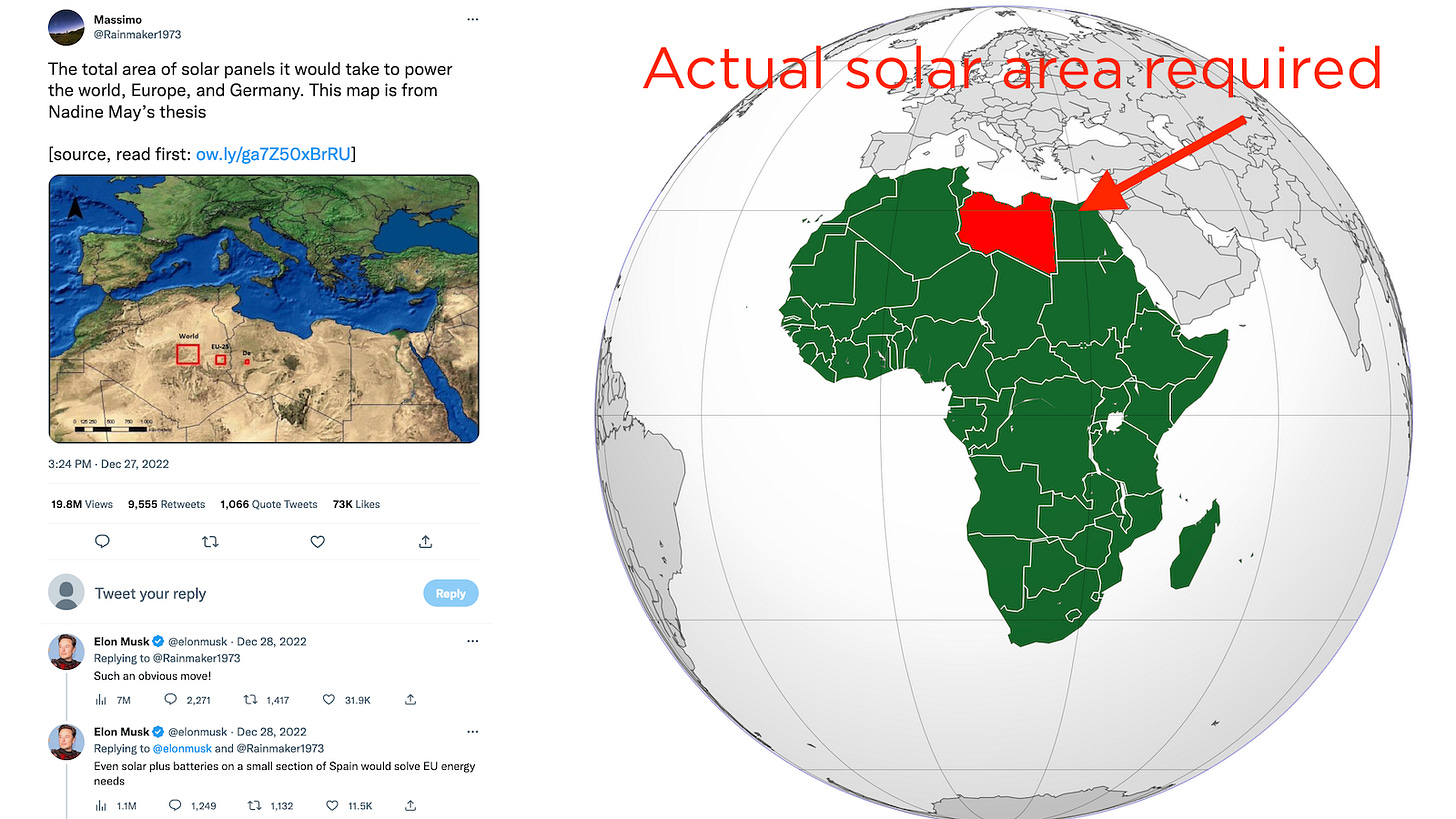Refuting the myth that just a small area of solar panels plus storage can power the world
Storing just 3 days of global energy would cost $590 trillion at Elon Musk’s current prices. And the panels would take up more space than all the world’s cities, towns, and villages combined.
Several weeks ago, a common and destructive myth—that just a small area of solar panels can power the world—went viral on Twitter with help from Elon Musk (who has repeatedly promoted this myth). I decided to demolish it once and for all. My own Twitter thread on this issue so far has well over a million views, and Jordan Peterson and Scott Adams (both of whom are regularly engaged by Musk) have publicly encouraged Musk and others to respond. If you’re on Twitter I hope you encourage @elonmusk to respond, too.
Myth: Just a small area of solar panels plus storage can power the world.
Truth: Storing just 3 days of global energy would cost $590 trillion at Elon Musk’s current prices. And the panels would take up more space than all the world’s cities, towns, and villages combined.1
We often hear that just a small area of solar panels plus storage batteries can power the world.
“Such an obvious move” says Elon Musk about this idea, adding “Even solar plus batteries on a small section of Spain would solve EU energy needs.”
This is dangerously false.Musk says that “to power the whole Earth” we need just solar panels and “some batteries.”
What is “some batteries”?
To store a mere 3 days of world energy, to be prepared for weeks (let alone seasons) with lower-than-usual sunlight, takes >1,350 terawatt-hours in batteries.2The world uses over 165k TWh of energy annually, or ~1.36 billion MWh in 3 days. 1000 Tesla Megapacks (3916 MWh of storage) have a price over >$1.7 billion. This would mean 3 days of storage using Tesla batteries would cost >$590 trillion. That's 6X world GDP!3
For those who think $590 trillion in batteries will somehow soon become cheap due to economies of scale, consider this: Tesla Megapack prices have been increasing, not rapidly decreasing, lately.
And efforts to scale batteries on an artificial timetable drive up prices.4The focus by Elon Musk and others on the space taken up by solar panels and batteries dodges the real issue: cost-effectiveness.
Due to stratospheric battery storage costs, no amount of solar panels can cost-effectively power the world.Arguing that solar panels and batteries can provide energy to 8 billion people using modest space is like arguing that Rolls-Royces can transport 8 billion people using modest space.
Yes, there’s space for 8 billion Rolls-Royces—but the human time it would take to produce them is cost-prohibitive.Another reason the world can’t be powered by solar panels and batteries: these only provide electricity—currently 1/5 of the world’s energy. Electricity can’t power many uses of energy (flight, cargo ships) and is very costly for others (many forms of industrial process heat).
The main lie of “Just a small area of solar panels can power the world” is that it ignores the insane cost of the necessary batteries.
But it also drastically underestimates how much space solar panels require.
For example, this viral Twitter post underestimates the area by some 25 times.5The world uses >165,000 TWh of energy per year, which requires ~19 billion kW of power output on average. An optimistic, real-world power density for solar projects is 10 W/m^2. To power the world, you’d need ~1.8 million km^2 of solar PV projects—about the size of Libya.6
If 1.8 million square km of solar panels doesn’t seem like much, note that it is more than all cities, towns, villages, and human infrastructure combined (~1.5 million sq km).
And this excludes the huge footprints of solar and battery mining, manufacturing, and transmission.7Summary: While we are told that the world can be powered by a small area of solar panels and batteries, the storage costs involved are impossibly high (hundreds of $trillions) and the panels involved would take up more area than all the world’s cities, towns, and villages combined.
The idea that the world can be powered by a small area of solar panels and batteries has been a major cause of today’s global energy crisis.
The world artificially restricted fossil fuel supply because smart people like Elon Musk told us we could use solar and batteries instead.Elon Musk has dramatically improved his energy rhetoric over the last year, acknowledging the need for oil and gas and walking back his past climate catastrophism. But he and others need to stop spreading the deadly idea that solar and batteries can power the world.8
If you’re on Twitter, please share these talking points there.
Popular links
EnergyTalkingPoints.com: Hundreds of concise, powerful, well-referenced talking points on energy, environmental, and climate issues.
My new book Fossil Future: Why Global Human Flourishing Requires More Oil, Coal, and Natural Gas—Not Less.
“Energy Talking Points by Alex Epstein” is my free Substack newsletter designed to give as many people as possible access to concise, powerful, well-referenced talking points on the latest energy, environmental, and climate issues from a pro-human, pro-energy perspective.
The world has a land area of almost 150 million square km. Only about 1% are “built-up” areas like villages, towns, cities, and other human infrastructure.









I have Elon Musk's solar panels on my roof, 8 months of the year they don't produce enough to power my house
Great job of refuting Elon’s rhetoric. In future refutations, I discourage you from alleging that he’s lying, when in fact, he’s likely arguing with faulty data. “Never attribute to malice that which is adequately explained by stupidity.” Hanlon’s Razor